

The fanon (old Germanic for cloth) is a vestment that around the 10th or 12th century became exclusively reserved for use by the pope during pontifical Mass. The Cardinal Patriarch of Lisbon has the same privilege. [1]


The fanon (old Germanic for cloth) is a vestment that around the 10th or 12th century became exclusively reserved for use by the pope during pontifical Mass. The Cardinal Patriarch of Lisbon has the same privilege. [1]
It consists of a doubled shoulder-cape (somewhat like a mozzetta) of white silk ornamented with narrow woven golden stripes, so that the colors alternate white and gold. The first layer of the fanon is placed under the stole and the second over the chasuble, under the white pallium. The two pieces of the fanon are nearly circular in shape but somewhat unequal in size and the smaller is laid over and fastened to the larger one. To allow the head to pass through, there is a round opening in the middle with a vertical slit running down the neckline at the back. The front part of the fanon is ornamented with a small cross embroidered in gold. [2]
The fanon is similar to an amice; it is, however, put on not under the alb, but above it. Previously, the pope wore it only when celebrating a solemn pontifical Mass, that is, only when all the pontifical vestments were used. The manner of putting on the fanon recalled the method of assuming the amice universal in the Middle Ages and that continued to be observed by some of the older religious orders. After the deacon vests the pope with the usual amice, alb, the cingulum and sub-cinctorium, and the pectoral cross, he places the fanon on the pope by means of the opening (with the embroidered cross in front), and then pulls the back half of the upper piece over the pope's head. Then he vests the pope with the stole, tunicle, dalmatic, and chasuble, after which he turns down that part of the fanon which had been placed over the head of the pope, draws the front half of the upper piece up from under the chasuble, and finally arranges the whole upper piece of the fanon so that it covers the shoulders of the pope like a collar. The pallium is placed over the fanon.[ citation needed ]

The fanon was regularly used until the Second Vatican Council but then fell into disuse, with Pope John Paul II wearing it once in the early 1980s during a visit to Roman convent.[ citation needed ]
On 21 October 2012, Pope Benedict XVI wore the fanon during a canonisation Mass, and again on 25 December 2012, and 6 January 2013. [3] [4] [5] Pope Francis since his election in 2013, has yet to use it, as of 2020 [update] ; one source considers that it “has ceased being commonly used.” [6]
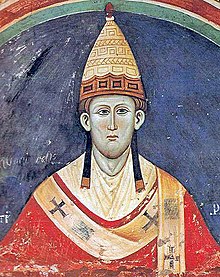
The fanon was mentioned in the oldest known Roman Ordinal, consequently its use in the eighth century can be proved. It was then called anabolagium (anagolagium), and was not yet at that period a vestment reserved for the use of the pope. This limitation of its use did not appear until the other ecclesiastics at Rome began to put the vestment on under the alb instead of over it, that is, when it became customary among the clergy to use the fanon as an ordinary amice. This happened, apparently in imitation of the usage outside of Rome, between the tenth and twelfth centuries; however, the exact date cannot be given.
But it is certain that as early as the end of the twelfth century the fanon was worn solely by the pope, as is evident from the express statement of Innocent III (1198–1216). The vestment was then called an orale; the name of fanon, from the late Latin fano, derived from pannus (penos), cloth, woven fabric, was not used until a subsequent age. Even as early as the eighth century the pope wore the fanon only at solemn high Mass. The usage according to which the pope was vested, in addition to the fanon, with an amice under the alb, did not appear, at the earliest, until the close of the Middle Ages.
As to the form of the fanon and the material from which it was made in early times, no positive information exists. Late in the Middle Ages it was made of white silk, as is shown by the inventory of the year 1295 of the papal treasure, as well as by numerous works of art; the favourite ornamentation was one of narrow stripes of gold and of some colour, especially red, woven into the silk. Up into the fifteenth century the fanon was square in shape; the later collar-like form seems to have appeared about the sixteenth century or even later.
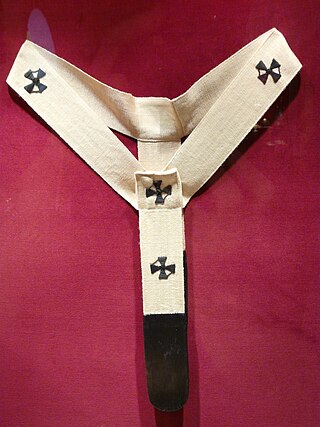
The pallium is an ecclesiastical vestment in the Catholic Church, originally peculiar to the Pope, but for many centuries bestowed by the Holy See upon metropolitans and primates as a symbol of their conferred jurisdictional authorities, and still remains a papal emblem.
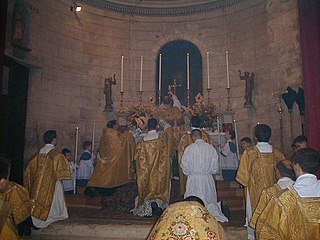
Vestments are liturgical garments and articles associated primarily with the Christian religion, especially by Eastern Churches, Catholics, Lutherans, and Anglicans. Many other groups also make use of liturgical garments; among the Reformed (Calvinist) Churches this was a point of controversy in the Protestant Reformation and sometimes since, in particular during the ritualist controversies in the Church of England in the 19th century.

A Pontifical High Mass, also called Solemn Pontifical Mass, is a Solemn or High Mass celebrated by a bishop using certain prescribed ceremonies. Although in modern English the word "pontifical" is almost exclusively associated with the pope, any bishop may be properly called a pontiff. Thus, the celebrant of a Pontifical High Mass may be the pope, any bishop or any other prelate who is allowed to wear pontificals.

The chasuble is the outermost liturgical vestment worn by clergy for the celebration of the Eucharist in Western-tradition Christian churches that use full vestments, primarily in Roman Catholic, Anglican, and Lutheran churches. In the Eastern Orthodox Churches and in the Eastern Catholic Churches, the equivalent vestment is the phelonion.

The dalmatic is a long, wide-sleeved tunic, which serves as a liturgical vestment in the Catholic, Lutheran, Anglican, United Methodist, and some other churches. When used, it is the proper vestment of a deacon at Mass, Holy Communion or other services such as baptism or marriage held in the context of a Eucharistic service. Although infrequent, it may also be worn by bishops above the alb and below the chasuble, and is then referred to as pontifical dalmatic.
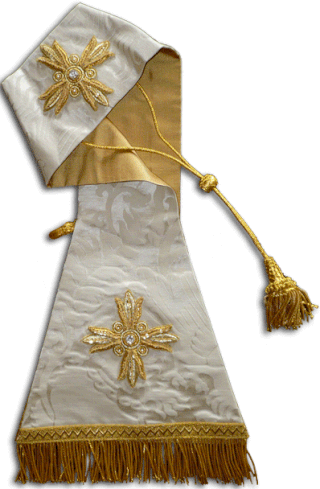
The maniple is a liturgical vestment used primarily within the Catholic Church, and occasionally used by some Anglo-Catholic and Lutheran clergy. It is an embroidered band of silk or similar fabric that is hung over the left arm. It is only used within the context of the Mass, and it is of the same liturgical colour as the other Mass vestments.
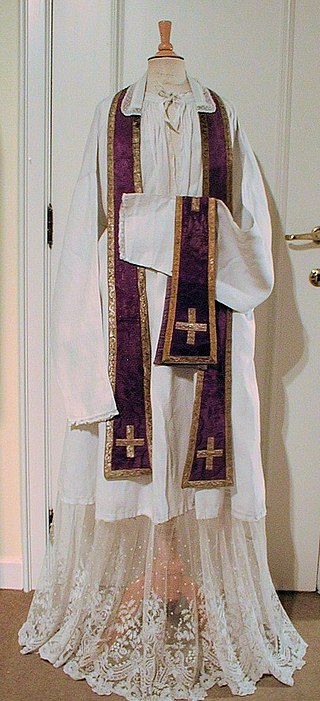
The alb is one of the liturgical vestments of Western Christianity. It is an ample white garment coming down to the ankles and is usually girdled with a cincture. It resembles the long, white linen tunic used by ancient Romans.

The cope is a liturgical vestment, more precisely a long mantle or cloak, open in front and fastened at the breast with a band or clasp. It may be of any liturgical colour.

A Papal Mass is the Solemn Pontifical High Mass celebrated by the Pope. It is celebrated on such occasions as a papal coronation, an ex cathedra pronouncement, the canonization of a saint, on Easter or Christmas or other major feast days.

Papal regalia and insignia are the official items of attire and decoration proper to the Pope in his capacity as the visible head of the Catholic Church and sovereign of the Vatican City State.
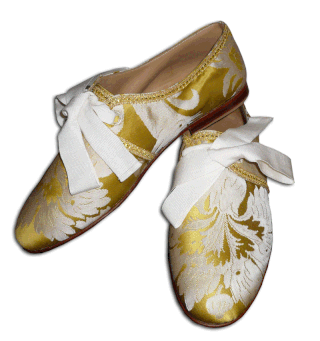
Episcopal sandals, also known as pontifical sandals, are a Catholic pontifical vestment worn by bishops when celebrating liturgical functions according to the pre–Vatican II rubrics, for example a Tridentine Solemn Pontifical Mass.

A pectoral cross or pectorale is a cross that is worn on the chest, usually suspended from the neck by a cord or chain. In ancient history and the Middle Ages, pectoral crosses were worn by both clergy and laity. By the Late Middle Ages, the pectoral cross came to be a special indicator of position worn by bishops. In the Roman Catholic Church, the wearing of a pectoral cross remains restricted to popes, cardinals, bishops and abbots. In Eastern Orthodox Church and Byzantine Catholic Churches that follow a Slavic Tradition, priests also wear pectoral crosses, while deacons and minor orders do not. The modern pectoral cross is relatively large, and is different from the small crosses worn on necklaces by many Christians. Most pectoral crosses are made of precious metals and some contain precious or semi-precious gems. Some contain a corpus like a crucifix while others use stylized designs and religious symbols.
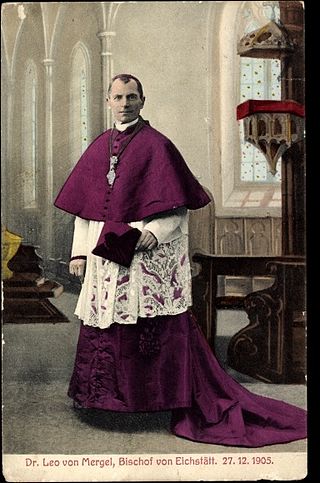
Choir dress is the traditional vesture of the clerics, seminarians and religious of Christian churches worn for public prayer and the administration of the sacraments except when celebrating or concelebrating the Eucharist. It differs from the vestments worn by the celebrants of the Eucharist, being normally made of fabrics such as wool, cotton or silk, as opposed to the fine brocades used in vestments. It may also be worn by lay assistants such as acolytes and choirs. It was abandoned by most of the Protestant churches that developed from the sixteenth-century Reformation.

The mozzetta is a short elbow-length sartorial vestment, a cape that covers the shoulders and is buttoned over the frontal breast area. It is worn over the rochet or cotta as part of choir dress by some of the clergy of the Catholic Church, among them the pope, cardinals, bishops, abbots, canons and religious superiors. There used to be a small hood on the back of the mozzetta of bishops and cardinals, but this was discontinued by Pope Paul VI. The hood, however, was retained in the mozzette of certain canons and abbots, and in that of the popes, often trimmed in satin, silk or ermine material.

Solemn Mass is the full ceremonial form of a Mass, predominantly associated with the Tridentine Mass where it is celebrated by a priest with a deacon and a subdeacon, requiring most of the parts of the Mass to be sung, and the use of incense. It is also called High Mass or Solemn High Mass.
A mantelletta, Italian diminutive of Latin mantellum 'mantle', is a sleeveless, knee-length, vest-like garment, open in front, with slits instead of sleeves on the sides, fastened at the neck. It was for a period of time even more common than the mozzetta.
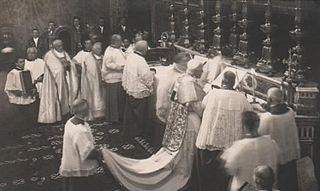
The falda is a particular papal vestment that forms a long skirt extending beneath the hem of the alb. When it is worn, the skirts of the falda are so long that the pope needs train-bearers both in front and behind while he walks. It was used when the pope celebrated Mass. It can be used as well by the Patriarch of Lisbon.
Pontifical vestments, also referred to as episcopal vestments or pontificals, are the liturgical vestments worn by bishops in the Catholic, Eastern Orthodox, Oriental Orthodox, Anglican, and some Lutheran churches, in addition to the usual priestly vestments for the celebration of the mass, other sacraments, sacramentals, and canonical hours. The pontifical vestments are only worn when celebrating or presiding over liturgical functions. As such, the garments should not be confused with choir dress, which are worn when attending liturgical functions but not celebrating or presiding.

The ceremonial of Benedict XVI (2005–2013) re-introduced several papal garments which had previously fallen into disuse.
The liturgical vestments of the Christian churches grew out of normal civil clothing, but the dress of church leaders began to be differentiated as early as the 4th century. By the end of the 13th century the forms used in the Roman Catholic and Eastern Orthodox churches had become established, while the Reformation led to changes in Protestant churches from the 16th century onward.